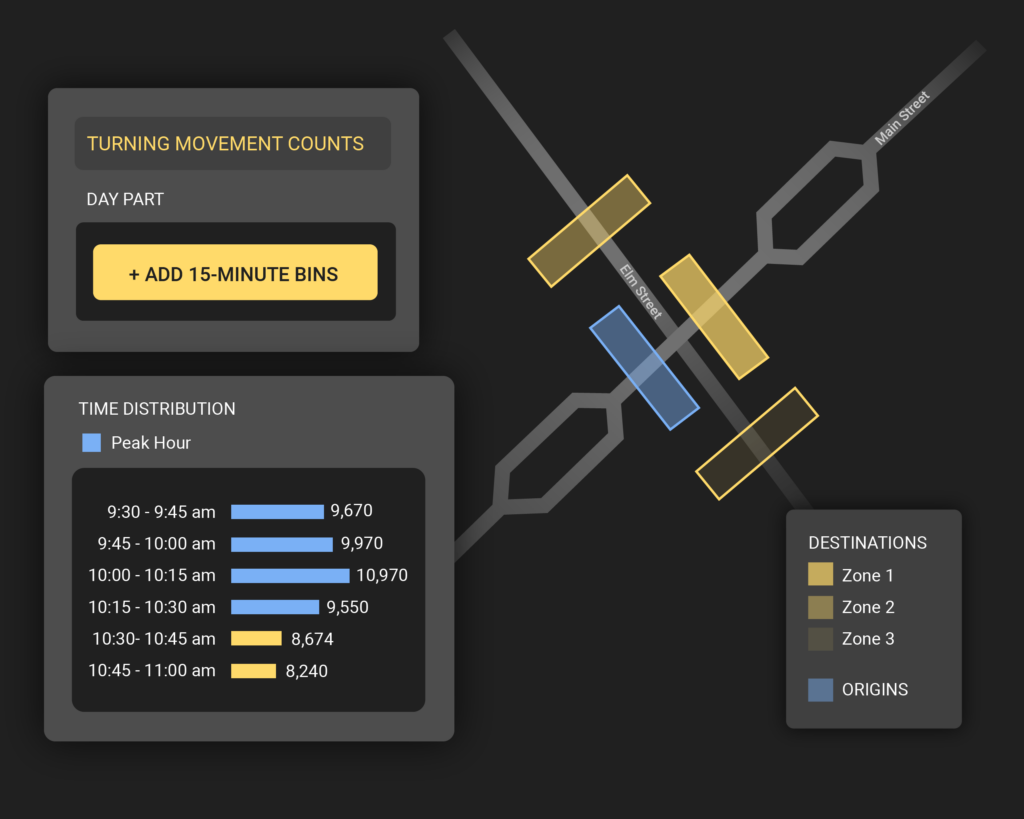Turning Movement Counts Explained: Leveraging TMC Analytics for Better, Safer Planning
For efficient, safe, and climate-friendly streets, planners, engineers, and traffic managers use turning movement counts to understand intersection performance. Here’s how they work.

Jump Ahead
In transportation analysis, turning movement counts (TMC) quantify the amount of traffic entering and exiting an intersection during a given period of time. These counts are often used to evaluate and implement intersection improvements that impact traffic operations, congestion, and safety.
Turning movement counts have aided traffic planners and civil engineers for decades. Manual two-hour TMCs originated in the 1950s, collected by workers who sat on street corners, pencils and paper in hand. In the 1970s, pneumatic tube counters made 24- and 48-hour counts possible. With today’s technology, on-demand analytics take TMC analysis to new levels.
Turning movement counts improve traffic flow, inform road upgrades, and much more, serving traffic planners and engineers alike. In this post, we’ll cover:
- How turning movement counts are collected
- The most common uses for turning movement data
- How on-demand TMC analytics are making transportation work easier and more impactful
How Are Turning Movement Counts Collected?
Traditionally, manual data collection at intersections involves the use of turning movement counters. For example, to track eastbound traffic at an intersection, technicians using electronic count boards note vehicles making right turns, left turns, or continuing straight through the intersection. Pedestrian and bicyclist movements are often recorded as well.

What Challenges Exist in Collecting Turning Movements?
Manual TMCs require that a technician accurately count every vehicle passing through the intersection. Obtaining accurate TMC is both laborious and limited in scope. In fact, it is not possible to use this method to get TMC for every intersection and for every relevant time period. Collection costs frequently restrict data collection to a day or two per year, and to limited parts of the day.
For this reason, agencies relying exclusively on manual counts may only gain a limited understanding of travel patterns. When extrapolating this limited data sample to a month or a year, planners and engineers often have to take findings with a grain of salt.
In response, automated data collection and analysis is gaining traction. Typically, automated traffic counters feature rubber tubes that detect wheels on straightaways. However, they’re limited in angled applications like intersections, as wheels on the same axle might hit the rubber tube at different times. Because these tools don’t account for the different angles at which vehicles enter intersections, traditional traffic counts may sometimes deliver flawed outputs. It is also cost-prohibitive to install traditional counters at every intersection.
Today, the use of Big Data provides a viable alternative. Big Data approaches to transportation analysis often combine location pings from connected vehicles and the Internet of Things with other data sources like road network maps and census data to algorithmically deliver analytics on how vehicles, people, and bicycles move.
This means that Big Data analytics deliver TMC without increasing infrastructure or labor costs for transportation agencies. For example, with Streetlight TMC, 24/7 counts for almost every intersection, signalized or not, are available for virtually every road in the both the United States and Canada.

How Turning Movement Count Data Is Used
Regardless of collection method, engineers, traffic planners, and even business owners can use TMC data for a variety of important purposes. Examples include:
- Traffic management and related topics like:
- Commute planning
- Tourism planning
- Safety planning
- Retail site selection
Traffic Management
Signal timing is often key to dealing with traffic congestion. And because congestion may be impacted by multiple intersections and indeed multiple roadways impacting one another, cities often need reliable turning movement counts for dozens of intersections or more in order to diagnose and address clogged traffic.
Signal retiming and optimization is one of the most cost-effective methods for managing traffic. In one study, the City of Boston noted just how cost-effective signal retiming can be.[1] When planners analyzed one-third of the city’s traffic signals in 20 travel corridors, retiming delivered a benefit-cost ratio of at least 83:1. Meanwhile, signal retiming plus various physical enhancements delivered a benefit-cost ratio of 61:1.
In general, modern TMC software can do much to overcome the challenges associated with staffing or budgetary shortfalls.
See how agencies are using TMC analytics to get traffic flowing safely
Watch WebinarCommute Planning
Traffic congestion typically spikes during morning and evening rush hours, when commuters are driving, biking, or walking to and from work. For this reason, commuting behaviors are of particular interest to traffic management efforts, especially when it comes to reducing congestion and addressing the concerns of constituents who may be impacted by long commutes.
Turning movement counts allow planners to accurately measure the impact of commuters on overall traffic patterns. Since commuter traffic typically flows one way in the morning and the opposite way in the evening, it’s important to have granular TMC data that can guide signal retiming and other traffic flow based on time of day.
Tourism Planning
Many communities see dramatic increases in vehicular, cyclist, and pedestrian traffic during the tourist season. This might be the summer for beachside communities, or the winter ski season for mountain communities. Cities that experience a major influx of seasonal tourists rely on TMCs to cope with changing traffic volumes and patterns that can turn free-flowing intersections into gridlocked roadways.
Safety Planning
Intersection safety has been a concern since motorized vehicles hit America’s streets. The first vehicle-related pedestrian fatality in the United States was recorded in 1899, when an electric-powered taxi struck a man who just stepped off a curb in Manhattan.[2]
In the United States, pedestrian fatalities have increased 80% since 2009.[3] According to the Institute for Transportation and Development Policy (ITDP), 55% of cyclist injuries and 26% of fatalities in the U.S. in 2020 occurred in intersections. Meanwhile, 41% of pedestrian injuries and 15% of pedestrian fatalities happened at intersections.[4]
Congestion can contribute heavily to these types of accidents. TMCs help officials identify effective ways to move vehicles through intersections, improving traffic flow while enhancing the safety of busy streets and thoroughfares.
In the video below, Joe DeVore of engineering and planning firm, KLJ, explains how the firm used StreetLight TMC to get a fuller picture of intersection safety and congestion in Minnesota, when traditional data collection methods would have limited analysis to peak traffic hours.
Retail Site Selection
Understanding traffic is also key to the selection of sites for retail businesses. Business stakeholders value locations that offer safe and convenient ingress and egress, as consumers often shy away from businesses where it is too difficult, dangerous, or time-consuming to arrive and depart.
Turn directions can significantly impact visitation to brick-and-mortar businesses. In the U.S., where vehicles travel on the right side of the road, right turns are typically much quicker, easier, and safer than left turns, meaning a business on the right side of traffic is likely to get more customers. Retailers can therefore use turning movement counts to choose which corner will be the most advantageous for a new store location, based on how many people are turning in each direction.
The Power of On-Demand TMC Analytics
For signal re-timing and other applications, traditional 48-hour TMCs may deliver insufficient sample sizes, and they can put members of your team in harm’s way. By comparison, modern analytics like StreetLight TMC use Big Data methods capable of providing TMC for the exact periods desired.
This enables planners and engineers to spend less time gathering data and more time analyzing it.
For example, in Brownsville, TX, when the pandemic foiled attempts to obtain accurate traffic counts, Hanson Professional Services used StreetLight’s on-demand TMC data to understand traffic flow at intersections during “typical” months – that is, months not impacted by holidays or vacation periods. After analyzing 200 traffic signals, Brownsville retimed 50 signals in order to improve traffic flow and safety.
Similarly, in Temecula — a bustling city of 112,000 in California’s Riverside County — city officials strategically deployed safety grant funds to better synchronize signals after freeways had grown congested to the point of gridlock. Engineers used StreetLight to collect historical TMC data at 40 key intersections in the city in a matter of hours. This allowed them to compare weekday and weekend traffic patterns to more precisely understand when traffic peaked and retime signals to unclog major thoroughfares.
To learn more about how StreetLight processes and validates turning movement data, check out our TMC validation white paper.
- Boston Transportation Department and Howard/Stein-Hudson Associates, Inc. “The Benefits of Retiming/Rephasing Traffic Signals in the Back Bay.” March 2010.
- Long, Tony. “Sept 13, 1899: New Yorker Becomes First U.S. Pedestrian Killed by Car.” Wired. September 13, 2011.
- Insurance Institute for Highway Safety, Highway Loss Data Institute. “Fatality Facts 2021, Pedestrians.” May 2023.
- Institute for Transportation & Development Policy. “We Need to Make Intersections Safer for Pedestrians and Cyclists.” August 17, 2022.

Put other agencies' TMC strategies to work for your community
Watch TMC WebinarReady to dive deeper and join the conversation?
Explore the resources listed above and don’t hesitate to reach out if you have any questions. We’re committed to fostering a collaborative community of transportation professionals dedicated to building a better future for our cities and communities.